The following are the experiences, thoughts, and philosophies from our preschool director, Sandy Rempe
Teaching Methods…
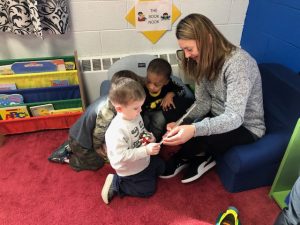
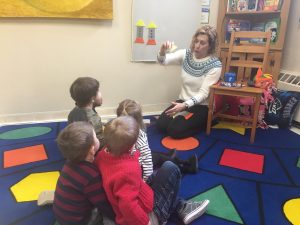
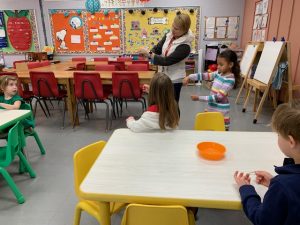
Over the years, I have studied various teaching approaches: Traditional, Reggio Emilia, and Maria Montessori, to name a few. While teaching children since 1996, I have found that most children respond best to a traditional teaching approach. Since our children’s brains are not developed yet, they are looking for teachers and parents to guide them in wisdom and to help them make sound decisions. They need to be taught to listen, have respect, share, and work cooperatively. We feel it is our job as preschool educators to guide them in the direction that will enable them to be able to learn at their highest capacity. This involves laying the foundation for the learning that will take place for the rest of their lives. This also involves teaching them the social skills they will need in order to learn and to function in relationships, schools, friendships, and any other social situations they may come in contact with.
During recent years, I have seen a real decline in the emphasis of the importance of traditional learning, and have also heard feedback from local school teachers that children are coming to school not socially prepared to learn. It seems like our society has been buying into educational ideas that may “sound good”, but lack the foundation, depth, or age-apppropriateness for the learning that children really need. Should children be the ones to decide what they want to learn? Children need to be taught how to learn. They need to be directed in focussed age appropriate curriculum and interactions designed for their age that will prepare them for the school years to come.
Throughout my teaching experience, I have had a few students transfer from other preschools where they were not instructed in the traditional teaching ways. I remember one of the children asking if was “okay” for her to play with the other children. I was shocked. “Of course, I want you to interact with the other children. That is what preschool is about. We learn how to work cooperatively with our friends.” I also had another transfer student who just wanted to do whatever he wanted to do whenever he wanted to do it. He had no idea how to follow a school routine, how to learn in a group setting, or take instruction from a teacher. From these experiences, it seems to me that if a child will be going into a traditional teaching school, which most of our local schools are, shouldn’t they be in a preschool that teaches in the same way?
Great Expectations…

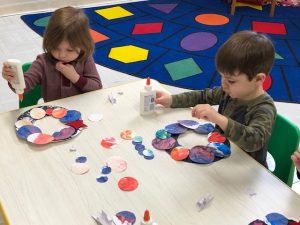
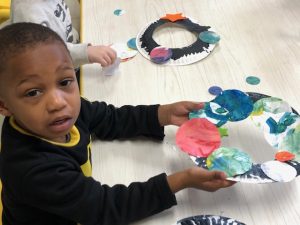
Our goal at A&HT Wyoming Preschool is to provide a safe and stimulating environment that promotes the social, emotional, intellectual, and physical development of each child enrolled. We realize that each child will grow and develop at their own rate. Some children will come to preschool already knowing their ABC’s, and 123’s. Some may just start recognizing their letters at the end of the preschool year. Some children may come to preschool knowing how to write their name, and some may not be writing at all. Over the course of the school year, we expose and instruct each child in academic skills such as letter recognition, counting, basic addition, writing, etc., but not all students will be ready to master these skills before the end of preschool, and that is OKAY. Our preschool goal is to set the stage for the learning, not to force children into activities that are not age-appropriate, or they are not ready for. When we do see a child developing in a certain area, we do our best to encourage that development along with the traditional preschool curriculum.
Throughout my teaching career, I have met all kinds of families and parents. The parents and families that I meet all have different expectations of what a child should be doing in preschool. At A&HT Wyoming Preschool, we have specific goals and objectives for each child to meet each year they are at preschool. These goals are based on standard age-appropriate educational standards, that work to prepare the preschooler for kindergarten. In fact, many of the same goals and objectives that we assess will be found on your child’s kindergarten report card. (This is true with Wyoming schools. Abe and Cal, my sons, worked on many of the same things in kindergarten that we covered in preschool). Please note that some of our goals may overlap from year to year, just like some of the kindergarten and Pre-K goals overlap. After all, don’t we all need to be reminded of proper social skills? Some of our art projects also may overlap from year to year. I have had some parents ask in the past “Why did my child make the same caterpillar/cocoon/butterfly project that they made last year?” I usually respond by explaining, “That is because repetition is so important at this young age. Also, a four-year-old will experience and perform the project in a completely different way than a three-year-old would. Plus, if we repeat the project we have found it beneficial to repeat it. Also, it is a darn good project that the children love and would learn from by doing again.”
I have also had some parents suggest that our preschool was not “academic enough”. My response is again, that we provide the foundations for learning through age-appropriate learning activities. Even if a child is reading fluently at age three, they still need preschool, and to participate in the preschool curriculum. For example, I have twin boys. Calvin was reading (and I don’t mean memorizing), before the age of 3. I remember the day my mom said that he read the word “Clubhouse” on the preschool play equipment. (I also remember not believing her and dismissing it as “grandma craziness”.) Abe started reading right around his 3rd birthday.* By four, they both could basically read almost anything I would put in front of them. (okay, they did get stuck on some words, like hysterical and Presbyterian). Calvin was especially obsessed with letters and numbers. He even went to his friend Sam’s house for a play date and convinced Sam to take down the letters that spelled out “SAM, ANNIE, and JANEY” off the wall, to play with. Sam’s mom said they had never experienced that before during a play date. Is this normal behavior? No! This kid needed preschool exposure and curriculum just like all kids who are of preschool age. Yes, he could read at a second grade level, but he was still continually putting his underwear on backwards! My other son, who was also a reading machine, was also emerging into quite a math wizard. He had worked his way through the addition and subtraction tables, and was beginning multiplication, but, of course, he, too, still needed to be in preschool. Since I was running a preschool, and teaching at preschool, Abe and Cal were exposed to the foundations of learning at an early age. (I do like to say they emerged quickly academically because of the great preschool they attended.) My husband and I did not expect the preschool curriculum to change to teach multiplication and have second grade reading groups. We realized the importance of Abe and Cal participating in an age-appropriate preschool learning environment. They needed to know how to deal with a kid that was poking them in the back during group time, or what to do when someone said something mean. We also realized it was important for us as parents to step it up at home and continue to introduce the next steps in their educational development, and not expect the school to be the one to meet all of my child’s educational needs. One year, I had a very bright student in class named Joey. His family did an excellent job of supporting the preschool curriculum, which they realized was important, and then offering Joey other learning opportunities during “home school” time. If the most of the class is well beyond standard preschool curriculum, we do expand and introduce the learning objectives they are ready for. If there is a child well-beyond the preschool curriculum, I do try to gear some of the lessons to their higher level of thinking, to help keep interest in the class content.
*Over the years, I have only had five students come through the preschool who could read, and that is including my two boys. I usually end up with some students who are beginning to recognize sight words by the end of their Pre-K year, and they are usually the older ones in class. We do work on sight words throughout the school year. Some will be able to recognize them, and some will still not be able to, but what is important is that they are exposed to the learning opportunity to begin recognizing them. Most children will begin to really read in Kindergarten, while some children reading will click in the beginning of first grade. True reading in preschool is rare.
Thoughts on Facilities…
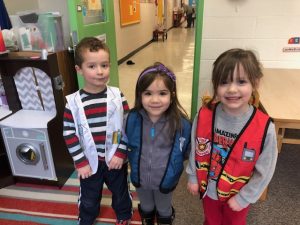
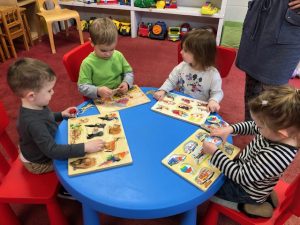

Many summers, I am able to spend some time in my hometown of Wooster, Ohio. During my stay, my twin boys, Abe and Cal usually attend a camp at the fine arts center, which means I actually have some free time. A lot of times I like to go and wander around the campus of the College of Wooster and relive some of my glory days. After all, I could still pass for a college student, right? Even though most of the students were away for the summer, many of the buildings were open, and I was able to meander my way through campus enjoying being around an atmosphere ripe with knowledge and learning. The college was built in 1900, and I have to say, there is just something about knowing that other people had been making the same walk and enjoying the same “spirit of seeking knowledge” that I was for over 100 years.
The church building our preschool is in isn’t new. It is old. It even smells old. The part we are in was built back in the late fifties and the rest of the building in 1929. There even used to be a county preschool here in the early sixties. Our building has seen many people walk through it’s hallways over the years. I have talked to some of the kids who grew up attending A&HT church and all of them have described the lower level, (okay, it’s a basement), where we are, as being “creepy and spooky.” When I walk through our school, I really do not get that feeling. I sense the same “spirit of seeking knowledge” that I felt walking around the College of Wooster. There is a history here and a sense of tradition that seems to be lost in the more modern buildings and facilities.
For some reason, our facility reminds me of the 1970’s movie, the Bad News Bears. The one that had Walter Matthau and Tatum O’Neal in it. (I really hope some of you reading this are old enough to remember that movie.) Their team, “The Bad News Bears”, practiced baseball on poor playing fields and had some very makeshift uniforms. They played these “fancy” teams who wore new, clean, and matching uniforms and practiced ball using new and modern, (for that time), fields. Of course, during the whole movie you just wanted those Bad News Bears to beat the snot out of that fancy team! Like the Bad News Bears, our preschool with our older facilities really can’t compete with other “fancy” schools. But I really wonder, is new always better? Isn’t it really about the relationship between the teacher and her students that is the most important thing toward learning development? Teachers are born to teach. They can teach anywhere. They can teach in nice facilities, old facilities, or even on the roof of the school building. I feel like so many times these days many parents make their decision for a school based on the “shininess and newness” of the facilities, instead of focusing on the instruction and learning opportunities their child will be given.
I actually love our “basement” preschool. We have tons of room and rooms. We have a super-sized Top Dogs room, a giant Playful Bunnies room, and and two adorable Cool Cats rooms. We have a preschool office, that has heat, and is bigger than a closet. (At my previous job, I had no heat for 3 years and the office was a closet!). We have a learning/snack/art room for the Playful Bunnies, we have bathrooms all over the place, a very large art closet, an amazing playground that was funded by The Pagliaro Family and storage, storage, storage! The favorite room for every preschooler is the “Muscle Room”. They absolutely adore having a room to go to that they are able to run, scream, and ride bike around and around. It’s even okay if they “accidentally” run into wall! We love the muscle room, too, because the preschoolers are developing their gross motor skills, getting exercise and learning to manage a “recess-like” environment. In fact, one of my preschool students, who has graduated from the Cleveland Art Institute, said one of his favorite memories of preschool was the muscle room.
Yes, we may have older facilities. Yes, we may have some blinds that need repaired, some bathrooms that could use sprucing, and some baseboards that need reattaching, but what we lack in facilities we truly make up for with teaching instruction. Plus, I think our students feel comfortable and a wonderful sense of ownership of our preschool. I’m a certain they will lovingly remember their “basement” preschool where their love of learning began.
School Rules…
For Top Dogs…


Over the years, we have tried some different behavior plans. Through trial and error, we have created our own plan that we have found really engages the preschool brain. It starts by introducing two characters. One character is the “good guy” and one character is the “bad guy”. For example, in the Top Dogs Class, we have Chip the Wonder Dog, and Awful Augie. We have pictures of them on our “behavior board” and use different adjectives to describe their character during class daily. Then, the teachers talk about different scenarios the characters end up in.
Also, in the Top Dogs Class, we will use the HOW I ACT chart. Each letter stands for a behavior we would like the students to steer clear from. The behaviors are as follows: H-Hullabaloo, O-Out of Order, W-Whining, I-Intentional disobedience, A-Attitude, C-Clowning around, and T-touching each other, tattling and throwing. Through the school year, we will use our classroom characters to act out appropriate classroom behavior, as well as the behaviors on the HOW I ACT chart. For example, the students viewed how Chip the Wonder Dog walked with slow steps, a controlled body, and no sound to the rainbow rug and sat down like a pretzel. (criss-cross applesauce) The students also viewed Awful Augie run, yell, scream, bump into people, jump in a bean bag, knock over books, and cause a big ruckus and commotion when dismissed from the snack table to the rainbow rug. We then compared and contrasted the behavior, and discussed which behavior was appropriate school behavior.
Next, we talk about choices and that the choices we make have a consequence. It could be a positive consequence, like a stamp at the end of the day, or a negative consequence, like time in a thinking chair, that we affectionately call the dog house. We also look at our How Am I Doing chart that has every student’s picture on it. Every student has a dog ball and a dog bone. If a student is not following one of the class rules, they start by “losing” their dog bone, which is just a reminder to make good choices. If the behavior continues, the student loses their dog ball, which means no stamp at the end of the day, but still a hug. We still love them, but do not love the choices they are making. Finally, if poor choices continue the student in placed in the dog house, or thinking chair, to think more about their behavior choices. Everyday is a fresh start with receiving their dog bone and dog ball back, and a reminder to make good choices.
During “D” week, we read the book by David Shannon, called “No, David”. We talk about the choices David made and the consequences of them. We also discussed how even though David made some bad decisions, his mom still loved him, but not his behavior. We applied this to our classroom and explained to the students that we would still love them even though they may make a bad behavior choice. Throughout the school day, we will be reminding students to act like Chip the Wonder Dog and not like Awful Augie.
We also love to reward good behavior by allowing students to pick items out of our “Top Dog Treats” jar, which is filled with lots of fun toys and gadgets which preschoolers love!
Finally, we teach out Top Dogs to “Stop, Think and Act”. If they are tempted to make a bad choice, we ask them to try to Stop what they are doing, Think about they are doing/want to do, and then Act out a good choice. We teach this through the Preschool Pal books.
For Cool Cats…
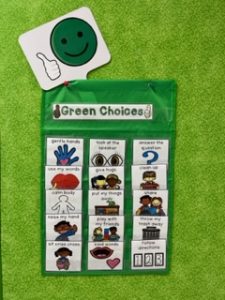

The Cool Cats use a simple behavior system using Green Choices (thumbs up) and Red Choices (thumbs down). This system is easy to use to encourage good behavior and discourage bad behaviors. We cover examples of Green and Red Choices the first part of the year with visual cards. Green choices include behaviors like looking at the teacher, sitting quietly, helping others, putting away toys, sharing, using kind words, following directions, and waiting. Red Choices include behaviors like taking all the toys, coloring on furniture, using mean words, making someone sad, pushing, laying on the floor during circle, and invading other’s space. After several warnings of Red Choices, a student may need to be removed from the classroom for a short time. Our goal with this system is to create a respectful community of preschoolers and teachers who can follow directions and treat each other with kindness.

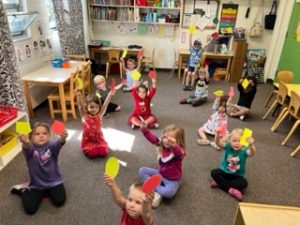
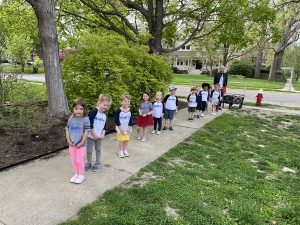
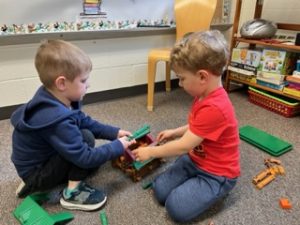
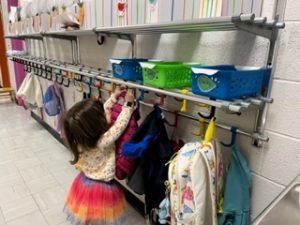
Thoughts on Snack and Lunch time…

There is no denying that food is a key component to life, especially so during the preschool years. Throughout my preschool teaching career, I have been asked pretty much every year about our snack policy. It seems like every parent has questions and opinions about snack. Comments range from “I think our kids today are snacking too frequently. Do you really think they need a snack at preschool?”, to “I’m so glad you have a nice, healthy snack because my child doesn’t eat that much for breakfast.” As far as the first opinion goes, I understand parents being concerned about the constant snacks given to children. If you participate in soccer, you are provided with a snack at the end of the game. If you participate in sports camp, you are provided with a snack mid-way. If you go to Sunday School, you have goldfish in little cups, or maybe, those great little sandwich cookies I had when I grew up. 🙂 I agree, that every time you turn around, it seems like kids are offered snacks. Consequently, at preschool, I feel it is a different level of snack. The children at preschool are in attendance for a decent amount of time and the nutritional needs of preschoolers are great because they are growing. Plus, their nutritional needs are greater than in later childhood. This is part of the reason take time for a whole group snack time and/or lunch time, daily.
Another reason we have decided to have a whole group snack time at preschool, is because I have seen over the years that children do not know how to sit and eat in a proper manner and with proper manners. (My twin boys still have a hard time with this, and we work on it all the time!) A lot of them do not know how to say “Please” and “Thank You” or how to eat without shoving food down their throat. Many children do not know how to converse with their classmates and eat at the same time. I have found over the years that whole group snack is the perfect place to teach children proper manners, which will help them in many ways in life including the school lunch room, dating, (!), and even business dinners.
Another objective that we focus on during snack time, is learning how to eat together at preschool without needing to be entertained. There is no television on, music, or a magician pulling rabbits out of hats. We work not only on our manners, but our conversation. Most days, we choose a special question to ask each student, such as, “What is your favorite color?”, or “What is your favorite book?”. During the second half of the school year, we encourage the preschool pals to be the one to ask the questions to their peers.
We also use whole group snack time, or lunch time with the Top Dogs, to help students learn how to manage their food, trash, and lunch box. When they move on to elementary school, the students only have a certain amount of time to eat. We do our best to help them learn to eat in the amount of time given. We also work to teach the preschoolers to learn to be responsible for opening the items in their lunch. After snack or lunch is over, we work on teaching the children what is trash, what can be recycled, and what to take home. Pretty much during the beginning teaching and training phase, someone throws away their lunchbox, (don’t worry, we dig it out of the trashcan) and we end up with leaky lunch boxes from open drink containers. As teachers, we do our best to inspect lunch boxes, to help prevent these issues, but sometimes things sneak by us. Please be understanding if an ice pack, spoon, or plastic container comes up missing, especially during the first weeks of school. With all this training, when I see our previous students in the elementary school cafeterias, it is evident that they are some of the more confident and well-prepared students in the lunchrooms.
Our preschool snack time also offers a time to learn about nutrition and nutritious foods. Many times I have witnessed students trying a new food at preschool, loving it, and then eating it at home. Many days, we will use this time to work on identifying food groups. We talk about Red, Yellow, and Green light foods. We also do our best to be neutral about food and to teach children to stop eating when their bellies are full. I have seen parents who restrict their child’s food choices so much, that when they do have a chance to eat something sweet, they can not stop, and try to hide food in their pockets. We also try to teach our students the importance of moderation. For example, it’s a good idea to try to limit red light foods, but it is also a good idea not to overeat just because it is a green light food. I feel very strongly about teaching preschoolers appropriate eating habits, especially, since I grew up with a grandma who insisted on a cookie for each hand and even encouraged us to “burp” so we would have more room to eat. How disgusting is that? PBS has aired a wonderful documentary about the aforementioned ideals called “The Parents’ Survival Guide: Childhood Obesity”. In it, they offered very rational, and very reasonable guidelines and suggestions about food consumption and children. As a preschool, we fall pretty much in line with the suggestions offered by the doctors interviewed in this investigation.
In summary, we feel that snack time/lunch time is an important learning opportunity, in many, many, ways! It provides nutrition for the needs of growing children, an opportunity to teach manners and learn to converse with classmates while eating, a chance to learn to eat in the allotted time, manage their food, trash and lunchbox. Students also become prepared for the lunchroom in following years, learn to listen to fullness cues, and how to eat in moderation. Overall, preschool snack times provides the building blocks needed to provide a healthy relationship with food, that hopefully, will become a life long lesson.
About arrival/dismissal…

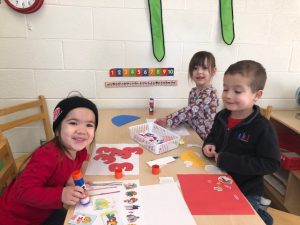
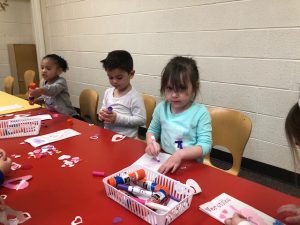
At our preschool each day, when school is about to begin, I high-tail it out of the classroom to make it up the steps in time to open the preschool door for our families. I love each day to be able to be the first person they see when they arrive to preschool. The girls usually like to show me their “beautiful” outfits and the boys have some kind of little gadget, or toy they like to show. I’ve even had one little boy insist he was having a baby and would show up a lot of times with a blanket in his shirt. During this time, I like to try to catch up on what is going on in my preschool families lives. It is truly a joy to get to know everyone and find out about how talented these moms, dads, and grandparents are.
Many years I am asked, “Do I need to walk my child into the preschool?” or “Have you ever thought about having the teachers come and get the students out of the cars?” Followed by, “I have a baby in the car and I’m watching a friends kid today, and it would be just so much more convenient if I could just have you come and get my preschooler from the car, or could I just let them walk in by on their own?” I totally sympathize with desiring convenience. If I didn’t think it was so important to your child’s development, safety, self-esteem, and confidence, to have a special person bring then to school, I would be the first person to start a car line, or allow your child to come in the school on their own. I think the simple gesture of walking your child to their classroom truly sets the tone for their day of learning. I absolutely love that I got to walk my sons to school everyday when they were at Elm. I know that it will be a very meaningful memory for them when they are grown. Therefore, we have decided it is the best interest of our students to be escorted to their preschool classroom, even if that means lugging other kids with you. After all, I had twins, and I’m sure you can imagine how inconvenient it used to be lug them around.*
Another reason we have decided we want parents to walk their child to the preschool classroom, is because we want to see you, and talk to you, and to get to know you better. We want you to see our school and to know us. We want you to see with your own eyes what we are doing in preschool and we want you to know the other wonderful parents and the other wonderful children who attend our school. We want you to be inconvenienced in a day an age where everything is about convenience. We want you to get off your cell phone, computer, and ipod and have a conversation with a real live person, and to actually get to know them, and maybe form a friendship. We want your other children to see our preschool and feel like they belong there, too. We also don’t want your child to feel they are being dumped off to one more place. We want them to realize how important it is to go to school and to get an education, and that is why you are bringing them to school. Right now in their lives, school is their job, just like mommy and daddy have jobs and responsibilities. School is important.
Pick-up is important, too. Students love it when someone they love picks them up from school. This could be a parent, a grandparent, or a special caregiver. Their faces light up when they see that someone special and are very excited to tell them all that they did that day at preschool. This is also a great time to check in shortly with the teacher. Our teachers do their best to give you a special detail about the day, whether your child did a great job gluing that day, recognizing letters, or writing their name. Sometimes, children are just so good at school we really run out of things to say, except “they had a great day.” I’ve had some parents over the years, say “You seem to always say my child had a great day at preschool.” I usually assure the parent that their child did indeed have another “great day” and that they seem to always have a great day at preschool, and that is why the feedback is the same. Some children just excel in a school environment, and end up always having a great day. I adored getting feedback about my boys during preschool. Whether it was “Calvin tried to climb the bookcase again, ” or “Abe seemed a little off today”, I appreciated getting a glimpse into how they acted during class. It was so hard for me to switch to “big girl school”, (which is what my friend Melissa calls “regular school”), where you just aren’t able to get as much daily feedback.
With our classrooms being where they are in the building, we have come up with a “traffic control plan”. Each day, we would like parents to enter through the side preschool door, where I am out greeting. Carefully, head down the steps, (honestly, I wish we had a slide and not steps, but couldn’t get the fire chief to go for that idea), and stop at your child’s name hook and mailbox. Check for mail, hang up coats, hats, backpacks and put any toys your child has brought with them away in their mailbox, or school bag. Next, proceed to your child’s classroom. You may drop your child off at the door of the classroom, or bring them inside the classroom, whichever you prefer. If you drop off your child at the classroom door, please make sure your child’s teacher sees you drop them off, so we can mark them in attendance on the attendance chart. If you prefer to come into the classroom for a few minutes to get your child settled, please try to leave within 15 minutes of arrival time. For example, if your child’s class starts at 9:00 A.M., please try to exit the classroom no later than 9:15 P.M. More than likely, your child will have an “attendance task” to perform on arrival. We use this to help our students transition from home time to school time. This may involve finding their name, or picture to hang up, or something to that effect. After your child has entered the classroom, we ask for everyone to go out the back stairway located on the other side of the muscle room. This really makes things so much easier for families still entering the building. This way, they are not navigating an arm load of stuff and children around exiting people. ** At pick-up time, we would like for you to come in the same door you entered. Pick up your child’s mail, bag, and coat and then line-up in the designated spot outside of your child’s classroom. When the class has ended, we will open the door, and start dismissing children in the order the parents are standing.***
Please note that the back door closest to the muscle room will be open daily for families who arrive to school early, or would like to stay after and play in. Also, we would love for all students to try to go to the bathroom upon arrival to preschool. If possible, try to keep siblings from crashing through the preschool doors at dismissal, and from engaging in sibling “tackle hugs” in the doorway during dismissal. Also, please remember to wait until it is your child’s preschool start time to bring them to their classroom. The teachers are still busy getting ready for the day, and every minute counts. Don’t be afraid to stop in the Preschool office to ask questions, or pick up handouts. Cindy loves to have visitors. (Keep in mind office hours end at 1:00 P.M. daily.) You are also more than welcome to hang out in the outside area called the “gathering place”. Please keep in mind to watch that your child is respectful to their surroundings while hanging out there. We have had some problem with rock throwing and some tree and shrub incidents.
*Please note that if you have a sibling who is with you who is ill, we prefer you that you NOT have the sibling come in the school with you. Please call the office and we will work out arrangements to help you get your child to and from their classroom.
**Please note that if someone new is picking up, or dropping off, we understand that they may not follow the traffic plan.
***Please understand that grandparents are notorious line jumpers, because they really have no idea where they are supposed to go, especially if they are not the ones who usually bring, or pick-up the child from preschool. We ask for everyone to please have patience with our lining up and traffic plan when some may unknowingly veer from the course.
What teachers want parents to know…
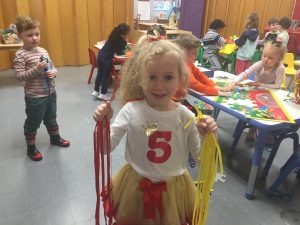
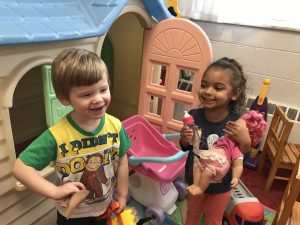
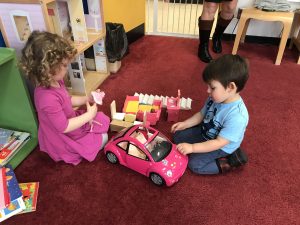
Your kids grow up too fast. We get them pretty much for 18 years, if that, because then the love interest will start coming around, sports team buddies, or academic team friends. Spend time with your kids now. I see so many parents of recent years who just do anything to have “ME” time. I don’t know if this all came from Oprah, or what, but they do whatever they can to dump their kid someplace to have this time. What they do during this “me” time has always been a mystery to me. I can spot these parents a mile away. They consider us “babysitting” so they can go do whatever it is they do in this “me” time, which is way more important than hanging out with their child. Please don’t get me wrong. I’m not talking about getting to go to the grocery store without everyone, (Tom and I had to make our “family fun day” going to Jungle Jim’s every Saturday, until the boys were about three when one of us was able to handle it ourselves!) or finally, getting to take a jog without pushing the heavy jogging stroller, meeting a friend for lunch, or even sneaking out on a date with your husband.
I also see parents who are just so desperate to drop their kid someplace, that they just want to believe whatever the program, school, nanny, tells them. Please take some time to talk to some other people about children’s programs, and not just believe everything that is put on the internet! I was using a gift certificate to Mitchell’s salon I had received from my lovely preschool families for an end of the year gift. I was talking to the hairdresser who was working on my hair about her experience with preschools. (Her child actually was in a daycare). She said they had checked out this place and was very excited about all it had to offer. She said she stopped in one day, and found out that she had bought the “hype” that this school was putting out, and the program was nothing like what it was claiming to be. She said she moved her child to a different daycare and made sure to do her research. Another indicator of a good program, is how long the staff has been working there. If there is a high turnover, that usually means there may be something questionable with the program, or their teachers just keep getting pregnant!
The Top Ten Best Things about A&HT Wyoming Preschool
10. The Science Guys-Two Julius Sumner Miller-esque personalities join us periodically to teach us Science. Experiments include color mixing, sink and float, elephant toothpaste, and Diet Coke/Mentos.
9. Classes that build on each other– Playful bunnies (two & three year olds), Cool Cats (three and four year olds) and Top Dogs class (four and five year olds, each build an age appropriate foundation for loving, learning and living. Top Dogs will be initiated into the class, receive their Top Dog ears, and become an official Top Dog!
8. A balance of work and play-“All work and no play makes Jack a dull boy.”-which is why we do a great job of mixing the two.
7. We, not me-Kyle Karate, a super hero in his own right, helps save letter people land from the nefarious Kaptain Kangaroo. These run-on characters help us realize that life is not “all about me, but about we”, which ends in a letter people musical fit for the whole family.
6. Traditional Teaching curriculum-based on the alphabet. Teachers instruct a time tested curriculum, which includes learning How to Act. Things like respect, kindness, teamwork, listening and How to “Stop, Think and Act”. Students are encouraged to act like “Chip the Wonder Dog” and not to act like “Awful Augie”. Dance, singing and clean up contests occur to help teach the preschool pals about being a good loser and a generous winner.
5. The Kindness Key-To encourage kindness, a preschool pal is picked each day to receive a kindness key for something kind he or she did that day. The tricky part is that they cannot tell the teacher what they did, in order to receive something, but must do it out of the kindness of their heart.
4. Family Holiday parties/Preschool Pal Performances-Halloween, Thanksgiving, and Christmas we gather as a preschool community to enjoy performances from our preschool pals. We also join in food, fun and games! The second half of the year we have in class parties: Valentine’s Day and Easter, and field trips: Fire Station, Library, Playgrounds, Butterfly show and Art Museum.
3. The Letter People-Based on the time honored curriculum, the letter people have become a part of our preschool world. A secret portal is located in our preschool closet, where the letter people join us after a secret knock and password, to teach us about their letter and sounds. A coloring sheet, testing book and test are administered each week. After learning the letter sounds, and putting them together, reading begins!
2. Experienced Teaching Staff-Our preschool is filled with high quality, experienced teachers who truly enjoy planning teaching our preschool pals. Not only that, but they posess strong character and great role models in school and out.
1. Love, Family and Relationships-Our preschool is MORE than a preschool. It is a community about living together in love, learning together and joining together as a preschool family. We gather food and warm clothing items to donate. We help each other out if a need arrises and we support each other during happy and sad time. WE ARE FAMILY!
